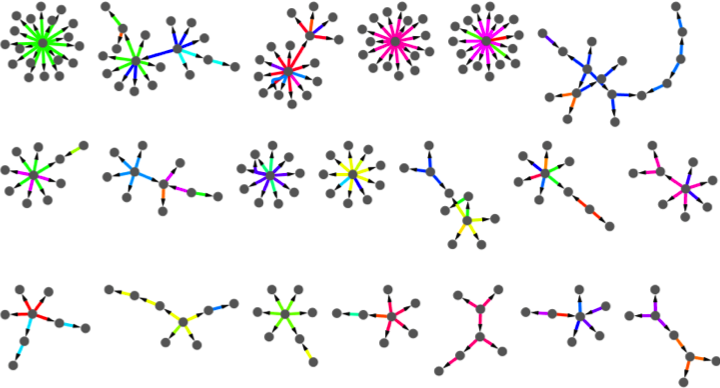Informationsverbreitung auf Twitter (30 wissenschaftliche Arbeiten)

Wunderschöne Informationskaskaden aus dem Paper von Kwak, Lee, Park und Moon [1].
– Im letzten Jahr hab ich fast jeden Tag ein Research Paper gelesen und bin dadurch mit jeder Menge neuer Themenfelder in Kontakt. Derzeit führt meine Exkursion quer durch die Twitter Social Science.
Die Sozialwissenschaftler lieben Twitter. 340 Millionen Tweets pro Tag. 140 Millionen aktive Nutzer. Ein sozialer Graph mit wahrscheinlich Billiarden gerichteter Kanten? Nie zuvor hatten die Soziologen so viele, wertvolle Daten zur Hand. Und das noch nahezu in Echtzeit.
Die unten stehende Sammlung umfasst alle Forschungsprojekte zu den drei Gebieten Complex Contagion, Information Cascade, Situation Awareness, die ich so finden konnte und dazu interessant fand (siehe Sternchenvergabe).
- What is Twitter, a Social Network or a News Media? (WWW 2010) ***
- Information Resonance on Twitter: Watching Iran (SOMA 2010) ***
- Who Says What to Whom on Twitter (WWW 2011) ***
- Differences in the Mechanics of Information Diffusion Across Topics: Idioms, Political Hashtags, and Complex Contagion on Twitter (WWW 2011) ***
- Entropy-based Classification of ‘Retweeting’ Activity on Twitter (SNA-KDD 2011) ***
- Unsupervised Modeling of Twitter Conversations (HLT 2010) ***
- Information diffussion in Social Media (Stanford CS224W 2011) **
- Tweet, Tweet, Retweet: Conversational Aspects of Retweeting on Twitter (HICSS 2010) **
- On Word-of-Mouth Based Discovery of the Web (IMC 2011) **
- How Does the Data Sampling Strategy Impact the Discovery of Information Diffusion in Social Media? (ICWSM 2010) **
- Measuring Message Propagation and Social Influence on Twitter.com (SocInfo 2010) **
- Classifying Trending Topics: A Typology of Conversation Triggers on Twitter (CIKM 2011) *
- Mapping Information Flows on Twitter (ICWSM 2011) *
- Conversational Tagging in Twitter (HT 2010) *
- The Revolutions Were Tweeted: Information Flows During the 2011 Tunisian and Egyptian Revolutions (IJoC 2011) *
- Conjoining Speeds up Information Diffusion in Overlaying Social-Physical Networks (arXiv) *
- Information Propagation on Twitter (Stanford CS224W 2009) *
- (How) Will the Revolution be Retweeted? Information Diffusion and the 2011 Egyptian Uprising (CSCW 2012) *
- Microblogging During Two Natural Hazards Events: What Twitter May Contribute to Situational Awareness (CHI 2010) *
- Dynamical Classes of Collective Attention in Twitter (WWW 2012) *
- Information Contagion: an Empirical Study of the Spread of News on Digg and Twitter Social Networks (ICWSM 2010) *
- Citation Analysis in Twitter: Approaches for Defining and Measuring Information Flows within Tweets during Scientific Conferences (MSM 2011) *
- How Far Does a Tweet Travel? Information Brokers in the Twitterverse (MSM 2010) *
- Analyzing the Dynamic Evolution of Hashtags on Twitter: a Language-Based Approach (LSM 2011) *
- A Study on Characteristics of Topic-Specific Information Cascade in Twitter (IEICE 2011) *
- Cross-Pollination of Information in Online Social Media: A Case Study on Popular Social Networks (SocialCom 2011) *
- The Pattern of Information Diffusion in Microblog (CoNEXT 2011 Student) *
- Pass It On?: Retweeting in Mass Emergency (ISCRAM 2010) *
- Pandemics in the Age of Twitter: Content Analysis of Tweets during the 2009 H1N1 Outbreak (PLoS ONE 2010) *
- Understanding how Twitter is used to spread scientific messages (Web Science 2010) *
Weil sich die Forschungsergebnisse unmöglich zusammenfassen lassen, einige Meta-Anmerkungen:
- Ein Vorhaben [22] stammt aus Deutschland. Ein weiteres [9] mit Beteiligung.
- In einer Untersuchung [20] taucht
#winnendenauf. - Circa ein Dutzend der Projekte trifft die naive Annahme, dass die Nutzer von Twitter tatsächlich alle Tweets der Verfolgten auch verfolgen. (Hmmm…)
- Ein Team [2] geht der Rolle der Twitter Search und Public Timeline detaillierter nach.
- Zwei Teams [16, 26] untersuchen die Fremdbestäubungseffekte sich überlagernder sozialer Netzwerke.
- Mehrere Analysen legen ad hoc Potenzgesetze zugrunde, mit stark schwankenden Exponenten. (Sind wissenschaftliche Arbeiten, die kein Power Law ausrufen, wertlos geworden?)
- Was mich wurmte: Da werden vielerlei Millionen von Status-Updates, Millionen von User-Profilen und Milliarden von Follow-Beziehungen erhoben, um anschließend nur die top-k Tweets, Hashtags, Trending Topics auszuwerten? Mit
kim Mittel 500? Wieso nicht Long Tail, Fat Tail, Unknown Unknowns? - Ein Team [10] stellt die Frage nach der Sampling-Methode.